The Top Bell Public House Leighton Buzzard
![The Bell about 1900 [Z1432/2/2/3]](/CommunityHistories/LeightonBuzzard/LeightonBuzzardimages/The-Top-Bell-about-1900-Z1432-2-2-3.jpg)
The Bell about 1900 [Z1432/2/2/3]
The Top Bell Public House: 10 Market Square, Leighton Buzzard [formerly the Bell then the Market Tavern]
The Manor of Leighton Buzzard alias Grovebury was the principal landowner in the town before the 19th century. Bedfordshire & Luton Archives & Records Service has a full run of court rolls from 1393 to 1727 [KK619-715] and another full run from 1704 to 1867 [X288/1-23]. The service also has court rolls for other manor to own land in the town, the Prebendal Manor, from 1448 to 1459, 1588 to 1591, 1611 to 1622, 1627 and 1631 [KK792-1798]. Detailed study of these would be bound to produce quite full histories for most licensed premises in the town. Unfortunately such study would take a very long time. Thus the histories of licensed premises in these web pages are quite summary and not necessarily the full story.
The earliest mention of the Bell so far found is in 1483, the year Richard III became King of England, the copyhold property of the Bell, an acre of meadow at "Ledon", twenty acres of arable land, partly at Leedon and partly at "Lekefurlong" along with a tenement called Fysshers were devised in the will of Thomas Palmer to his son, John and, after his death without heirs, to the churchwardens of All Saints [KK142]. The will recites that Palmer had previously bought the buildings and land from John Broughton. [KK142] John Broughton to Thomas Palmer. John Palmer died in 1498 and his death was duly presented at the manorial court along with the statement that he had a licence to raise the sign of an inn at the Bell in the highway. Interestingly this Bell may have been on the north side of the Market Square or the High Street as the presentment goes on that he also had land next the land of the Bell and land called Fishers on the south and Friday's Lane [the modern West Street] on the north [KK944/4]. In 1506 a cart way was surrendered that led from the Bell Inn to Friday's Lane which adds weight to the theory that the original Bell lay on the north side of Market Square or High Street [KK944/4]
John Palmer obviously died without issue because, true to his father's will, the Bell was demised by his father's executors to All Saints churchwardens William Taillour, Richard Noke and John Halsey in 1499 [KK142]. Nothing is then heard of the Bell until 1621 when John Wilckes paid a quitrent of a penny for it [KK775]. Quitrents were paid on freehold property. Without further evidence it is impossible to say for sure whether the churchwardens enfranchised the property (i.e. converted it from copyhold to freehold by paying a fine to the Lord of the Manor) or whether they closed it and the Bell of 1621 is the current public house on the south side of the Market Square, the balance of probability, however, would seem to favour the latter. John Wilkes was still paying his penny quitrent in 1626, he also owned the Talbot [KK776]. By 1656 the quitrent was being paid by Mathewe Wilkes [KK780]
In 1683 a theft occurred at the Bell. The case came before the assizes, the confession of the thief reads as follows, note the archaic spellings [HSA1684/W/64]: “The Examinacon of Richard Fletcher of Goldinge Lane London, taken upon oath, the ninth day of September Anno Domini 1683 before St John Thomson Esquire one of his Majestie’s Justices of the Peace for the County of Bedford as followeth This Examinant saith that hee tooke out of the breeches pockette of Robert Simmons of Edminton in the County of Middlesex butcher, as they lay in one of the Bell chambers in Laighton Bussard in the said county of Bedford, the sum of eleven poundes and tenne shillinges, and that one John Goodsoale of Laighton aforesaid collarmaker, tooke againe from him eleven poundes & seven shillinges, and the rest hee had disposed of, and further saith not. St. JohnThomson”.
In 1683 Mathew Disney and Sarah Ironside were preparing to marry and as part of the settlement Mathew Wilks, living at Lillingstone Dayrell [Buckinghamshire] and evidently a relative of either Disney or Ironside, conveyed the Bell to trustees to form part of her jointure [F209/13-14]. In 1705 Mathew Disney conveyed the Bell to a trustee in order to bar the entail set up by the marriage settlement [F209/9]. By 1749 the Bell was owned by Justice of the Peace John Salusbury who paid the penny quitrent [KK783] as he did in 1755 [KK784]
In 1960 Bedfordshire Historical Records Society published a volume, its fortieth, dedicated to diaries. County Archivist Joyce Godber edited and published the diary of John Salusbury (1712-1787) written between the years 1757 and 1759. On 31st October 1757, his 45th birthday, Salusbury recorded that he ate with friends at the Bell where "there was a profusion of provisions". Quit rentals for the Manor of Leighton Buzzard [KK783] record that Salusbury paid a penny quit rent on the inn from 1749 to 1753 and so presumably owned it. Salusbury spent two shillings at the Bell with friends on 3rd April 1758. On 15th May he again met friends at the public house to "taste of their new port, which is very good". He drank a bottle of wine there with two friends on the afternoon of 29th June.
On 12th September 1759 Salusbury recorded: "Dined at the Bell, being the day of appeals. No [one] but town commissioners came, so Messrs. Ashwell, Perrott, Franklin and self were obliged to sit down to a profusion of victuals". On 3rd October he had business at the Bell where he bound an apprentice to a Mursley [Buckinghamshire], butcher, no doubt it was a convenient meeting place for such business. On 1st November he dined at the Bell "being a prebendal visitation [that is the Prebend of Leighton Buzzard was visiting his Peculiar and church]. A very thin company, however some of us stayed till near 12 [midday], spent 18 pence". Ten days later he met bakers at the inn "and read over to them the new law about the bread; we spent sixpence apiece and they all agreed to make only peck, half peck, quarten and one penny and two penny loaves, they being confined by the late Act to one kind". On 17th August 1759 Salusbury was again doing business at the Bell: "Bound at the Bell Robert Chandler of Soulbury to John Chandler, his brother, of Wilstone, tailor, and paid him £5, the consideration money ordered by the trustees…we drink a bottle apiece, but I breaking a glass it cost me half a crown". The final mention of the Bell was an evening spent there with friends on 5th November 1759. Salusbury was still paying the penny quitrent in 1772 [KK785].
In the Northampton Mercury of 19th January 1793 licensee of the Angel, William Saunders subscribed to a resolution of Leighton Buzzard publicans banning "seditious and disaffected persons" from their houses. This presumably was in reaction to the events across the Channel in France (four days previously King Louis XVI had been sentenced to death and two days later he went to the guillotine).
The countywide Return of Licensed Premises of 1876 gave the owner as George Holdam of Fenny Stratford and stated that the inn was first licensed in 1780 – which is clearly wrong, unless the inn closed for some reason and re-opened, a detailed study of manorial records should resolve this problem. By the time of the countywide return of 1891 the owner was George Gale of Leighton Buzzard. By 1904 the owner was Welch Ale Brewery when licensee Walter James Morse agreed to sell the tenancy to Auguste Francois Pouchot of 29 Claverton Street, Saint George’s Square, London [HN10/371/Pouchot1]. Curiously the licence did not change until 1907 [PSLB4/1]. In 1906 Pouchot took a lease himself from Welch Ale [HN10/371/Pouchot3]. Two years later it appears that Pouchot and his wife were separated as there is a letter from him to his wife relating to custody and access arrangement regarding their son John Auguste [HN10/371/Pouchot6]. Pouchot returned to London and his wife ran the Bell [HN10/371/Pouchot7]. An insurance certificate under the Workmen's Compensation Act shows that Emily employed three servants at the Bell - a barmaid, a domestic servant and a yard man in 1910 [HN10/371/Pouchot9].

Fire at the Bell [Z1306/72]
Just as Emily's life must have seemed to have regained some equilibrium there was a disastrous accident. It occurred on 2nd September 1911 and was reported by the Luton News of 7th September: "The inhabitants of Leighton Buzzard were thrown into a state of great excitement on Saturday afternoon, when it was rumoured that one of the principal hotels in the town was on fire. The rumour proved only too true, a serious fire having broken out at the Bell Hotel, situated in the High Street [sic], just opposite the Town Hall. The alarm was raised about twenty minutes past two, and with commendable promptitude the Leighton Buzzard Fire Brigade were upon the scene".
"Shortly after two o'clock Mrs. Pouchot, the landlady, was making the necessary arrangements preparatory to taking a bath, when, on applying a match to an oil geyser, a violent explosion took place, doubtless consequent upon a quantity of vaporous oil having escaped from the geyser. Mrs. Pouchot, who was fully clad at the time of the explosion, was caught by the flames and her clothing immediately became ignited. Unable to extinguish the flames, the landlady rushed frantically from room to room uttering piercing screams. Attracted by the screams, the barmaid, Miss Hetty Mason, went upstairs with the utmost despatch, and there saw her mistress in flames. With great presence of mind, the barmaid wrapped a table cloth round her mistress but, unfortunately, in so doing, she sustained severe burns to her hands and arms. A stranger who happened to be in the hotel at the time also rendered valuable assistance".
"A large crowd had, by this time, arrived on the scene, but one of the first to enter the hotel was Mr. E. Halford, jeweller, who found Mrs. Pouchot lying at the bottom of the stairs. Helping her to her feet, he assisted her, as soon as it was possible, across the road to his residence, which was directly opposite to the now burning building. Dr. Spencer Pearson, who happened to be passing at the time, was called in and he rendered excellent service. He found that the lady was suffering from very severe burns on the legs, arms, chest, and face. A quantity of her hair had also been burnt away, and her condition was extremely critical. The unfortunate lady's sufferings were greatly alleviated by the aid - until the arrival of the doctor - of the Misses Halford. The injuries of the barmaid, Miss Mason, were attended to at Mr. Herington's shop [chemist at 16 Market Square]".

16 Market Square June 2008 - in 1911 Mr. Herington, the chemist's
"Having attended Mrs. Pouchot and seen her into safety, Miss Mason raised the alarm, and the Fire Brigade were upon the scene a few minutes later. They were soon playing down the flames, which by this time had gained a considerable hold, having reached the roofs of the other rooms on the same floor. The firemen were confronted with a very difficult task in preventing the flames from spreading to the adjoining premises of Messrs. Cooper and Co. [ironmongers] and Mr. Spiers [ironmonger and silver smith], where some benzoline, gunpowder and other combustibles were stored. Notwithstanding their efforts, the flames gradually gained ground, and they slowly spread to the roof of Messrs. Eastmans premises [butchers], which extended to those of Messrs. Cooper and Co. The men, however, thanks to their untiring efforts, eventually succeeded in gaining the upper hand and, keeping steadily at work, the outbreak was then extinguished in a comparatively short time. Some of the furniture in the lower rooms of the hotel had previously been removed to a place of safety, and the meat at Messrs. Eastman's shop had also been removed. Whilst preparations had been made for the immediate removal of the stock of inflammables from the shop of Messrs Cooper, it was not found necessary for that course to be adopted. The hotel premises were badly damaged; what had not been destroyed by fire had been destroyed by water. The billiard table, which was untouched by the flames, was much damaged by water".
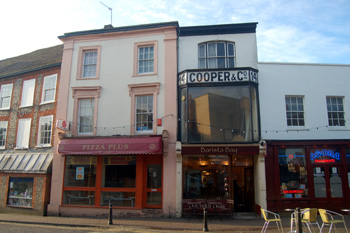
14 Market Square June 2008 - Cooper's ironmongers in 1911
"No better testimony to the excellent work of the Brigade could be given than mentioning the fact that the damage is estimated at only a few hundred pounds".
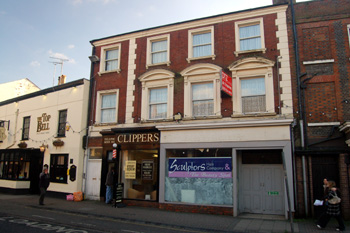
8 Market Square December 2008 - in 1911 Mr. Spiers, the ironmongers
In the next week's edition the Luton News had some more sad news: "The disastrous fire which occurred at the Bell Hotel, Leighton Buzzard, on Saturday week, was not unattended by loss of life, the landlady, Mrs. Pouchot succumbing to her injuries on Thursday morning at the residence of Mr, Halford, jeweller, of Market-square, where she was taken after the fire"
"The inquest was held at the Bell Hotel on Friday, Mr. Mark Whyley (the coroner) conducted the inquiry and Mr. Robert Platten was chosen foreman of the jury".
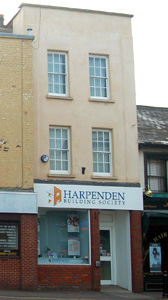
22 Market Square Jun 2008 - in 1911 Mr. Halford, the jeweller's, where Emily Pouchot died
Following a lengthy review of the court proceedings the article summed up: "Evidence as to the extent of the injuries received by Mrs. Pouchot was given by Dr. Pearson, who informed the jury that he was riding through the High Street on the Saturday afternoon when he saw smoke coming from the Bell. As he was passing he saw Mr. Halford some out and go across the road leading Mrs. Pouchot. Witness could see that the lady was more or less severely burnt and therefore followed them into the house and upstairs into the bedroom where he, with the assistance of Miss Halford, removed Mrs. Pouchot's clothes. He sent to the chemist's immediately opposite for some dressings, which were promptly supplied. Witness then dressed the wounds and finding that Mrs. Pouchot was rapidly becoming collapsed be endeavoured and succeeded in reviving her. At the request of the lady he attended her until the time of her death. Describing her injuries witness said that she was severely burned on both arms and the hands especially so and had she lived the skin on the arms would have been destroyed. The hands were burnt to the bones. The upper two thirds of the back were severely scorched and in places the skin was destroyed. The right side, thigh and legs were also burnt. Death took place at five o'clock on Thursday morning consequent upon the burns".
"In answer to questions by the jurors, the doctor said that the deceased was not at all delicate of health but rather robust".
"The Coroner, in reviewing the evidence, pointed out the dangerous nature of the oil geysers and described several accidents which had resulted from explosions of similar geysers. The geyser in question was undoubtedly one of the old fashioned type. He thought, however, that the jury would have no difficulty in arriving at their verdict. Evidence of the cause of the fire had been laid before them and it was clear that the outbreak was the result of a pure accident. He paid a high tribute to the work of the two first witnesses, the police, and the Fire Brigade".
The jury returned a verdict of accidental death. The 1911 census reveals that Emily Marian Pouchot had been born in Bletchley [Buckinghamshire], explaining why she and her husband had looked for a hotel in this area. Her son, John Augustus Pouchot, then twelve years age, was living with her, as per the custody agreement. He had been born in Victoria, London. Only two servants are mentioned as living in (Hetty Mason was presumably local), Louie Podd, an 18 year old bachelor, born in Walthamstow, described as a general servant, and Clarrer [presumably a mis-spelling of Clara or Clarrie] Norris, a single woman aged seventeen, born in Brixton, who was described as barmaid.
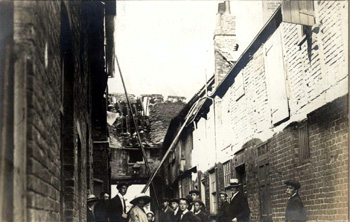
The aftermath of the fire at The Bell [Z1306/72]
Following the fire and Emily Pouchot's death G. Payne of Dunstable, hotel and tavern valuer, made efforts to find both an owner and a tenant for the hotel [HN10/371/Pouchot12]. Emily Pouchot's will left everything to her son once he came of age [HN10/371/Pouchot13]. Payne eventually succeeded in leasing the Bell to Horace Lionel Harvey of Stratford [Middlesex] [HN10/371/Pouchot19] although Leonard William Barber of 43 Carnaby Street West, London became licensee [HN10/371/Pouchot23 and PSLB4/1]. Emily left debts amounting to £1,230/4/10, some of it owed to her mother Mary Holdom [HN10/371/Pouchot22].
After the death of his mother Emily's son, John Auguste Pouchot (known as Jack) was fostered by a Mrs. Hawkswood of Kingston-on-Thames. Jack, a former pupil of Beaudesert School, joined the Queen's Westminster Rifles while considerably under age. When he was just sixteen years old he become the youngest ever recipient of the Distinguished Conduct Medal, an award for conspicuous bravery second only to the Victoria Cross, for his gallant conduct in trying to the save the life of a wounded comrade. A corporal went out at night to collect water but misjudged the time. As he returned dawn broke, leaving his silhouette clear to the German snipers. He was shot while still 50 yards from the trench. Rifleman Pouchot left the trench and crawled to the wounded man who had a terribly wounded face and was gasping for breath. As he tried to apply the corporal’s field dressing another comrade, Rifleman Tibbs, joined them. While trying to bandage the wounded man Tibbs was also shot and killed. Pouchot continued to apply first aid until the corporal died and he was ordered by an officer to return to the trench. This action took place in January 1915, at which time Jack Pouchot was only fifteen years old. He subsequently joined the Royal Air Force and was killed on 5th October 1918. His age at death is given by the Commonwealth War Graves Commission as twenty, but he was in fact only nineteen.
The Top Bell, then called the Market Tavern, was listed by the former Department of Environment in 1975 as Grade II, of special interest. It was assessed as being a 19th century building with a stucco roof and Welsh slated roof. It is unclear as to whether this date was as a result of rebuilding in the 19th century or rebuilding after the fire of 1911. In 1990 planning consent was given for a two storey rear extension and internal alterations. After a spell in the 1970s and 1980s as the Market Tavern the public house reverted to its old name until at least 2006. At the time of writing [2009] it remains a public house but is called the Top Bell.

The Bell July 2006
References:
- KK142: recited demise: before 1483;
- KK142: recited will: 1483;
- KK944/4: presentment of the death1498;
- KK142: demise: 1499;
- KK944/4: surrender: 1506;
- KK944/4: surrender: 1507;
- KK775: Manor of Leighton Buzzard quit rental: 1621;
- KK776: Manor of Leighton Buzzard quit rental: 1626;
- STuncat368: deeds to 8 Market Square: 1635-1881;
- KK780: Manor of Leighton Buzzard quit rental: 1656;
- HSA1684/W/64: theft at The Bell: 1683;
- F209/13-14: marriage settlement: 1683;
- F209/9: conveyance: 1705;
- X561/1-54: deeds of property built in Bell Yard: 1749-1887;
- KK783: Manor of Leighton Buzzard quit rental: 1749;
- KK784: Manor of Leighton Buzzard quit rental: 1755;
- KK785: Manor of Leighton Buzzard quit rental: 1772;
- PSLB4/1: notes first licensed without name or evidence: 1780;
- Northampton Mercury: resolution of Leighton Buzzard publicans banning "seditious and disaffected persons" from their houses: 19 Jan 1793 [both George Harrison and Thomas Rogers junior are recorded at the Bell indicating that there were two different public houses of this name];
- CLP13: Register of alehouse licences: 1822-1828;
- PSLB4/1: Register of Alehouse Licences - Leighton Buzzard Petty Sessional Division: c.1860s-1949;
- PSLB4/3: Register of Alehouse Licences - Leighton Buzzard Petty Sessional Division: c.1860s-1956;
- BML10/42/59: sale book: 1880;
- HN1/20-1-3: position shown on annotated Ordnance Survey maps compiled for licensing purposes: early 20th century;
- P91/28/48: indicated as being at 10 Market Square in notes compiled on Leighton Buzzard public houses: early 20th century;
- CRT110/99: agreement to lease effects: 1900;
- HN10/371/Pouchot1: agreement to sell licence: 1904;
- HN10/371/Pouchot3: lease: 1906;
- HN10/371/POuchot5: account book: 1908;
- HN10/371/Pouchot7: assignment of lease: 1908;
- HN10/371/Pouchot8: invoices: 1909-1911;
- HN10/371/Pouchot9: insurance certificate: 1910;
- HN10/371/Pouchot10: insurance company letter regarding fire at the public house: 1911;
- Bedfordshire Inns & Pubs in Old Picture Postcards: shows fire at Bell: 1911;
- HN10/371/Pouchot12: attempts to find a tenant: 1911-1912;
- HN10/371/Pouchot13: will of Emily Marion Pouchot: 1911;
- HN10/371/Pouchot19: agreement: 1911;
- BML10/42/375: inventory and valuation of part of Bell: 1912;
- HN10/371/Pouchot23: tenancy agreement: 1912;
- PSLB4/2: Register of Alehouse Licences - Leighton Buzzard Petty Sessional Division: 1922-1948
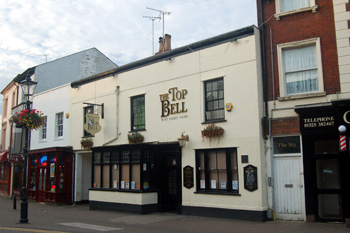
Top Bell June 2008
List of Licensees: note that this is not a complete list; entries in italics refer to licensees where either beginning or end, or both, dates are not known:
1705: William Whippam;
1756: James Stanbridge;
1793: George Harrison or Thomas Rogers junior;
1822: Coleman Ginger;
1839: Thomas Ginger;
1847: John Evans;
1850: Thomas Ginger;
1853 Mrs Elizabeth Ginger;
1882: Charles Pickering;
1882: Joseph Woodman;
1887: George Gale;
1900: Ardley John Humphreys;
1901: George Christopher Ganger;
1902: George Morris;
1904: Mary Morris;
1904: William Martin Kirby;
1904: Walter James Morse;
1907: Auguste Francois Pouchot;
1908: Emily Marian Pouchot;
1912: Robert George Holdom and William Woods (executors of E. M. Pouchot);
1912: Leonard William Barber;
1913: Nora Selby Cobb;
1913: John Richard Hunt;
1916: Robert Everitt;
1919: John Langford;
1920: Lyell Maxfield;
1933: Edwin Talbot Ball;
1938: Sidney James Land;
1950: George Francis Horwood;
1950-1951: Arthur George Bailey;
1951: Charles Francis James Ludbrook;
1952: Ernest Walter Fowkes;
1954: William Henry Cockhill;
1966: Wojciech Sekula;
1967: Frederick William Foley;
1969: John Edward Scotney;
1970: Samuel Barrett;
1972: Donald Gascoigne Bates;
1973: Richard John Vines;
1973: Allan William Owen;
1974: Eric Darby;
1976: Michael Charles Severs;
1977: Ronald Peverley;
1979: Jack Edward Lee;
1981: Michael Burkinshaw;
1982: Michael Bown;
1983: Leslie John Wood;
1983: John Unsworth;
1985: Robin William Buffrey;
1985: Patrick Long;
1986: Danny Hobden;
1986: Paul Regenold Baker;
1987: Frederick Allan Apicella;
1991: Frederick Allan Apicella and Josephine Mary Apicella;
1992: David Richard West and Stanley Albert Dolling;
1992: Annette Margaret Parry;
1993: Annette Margaret Parry and David West